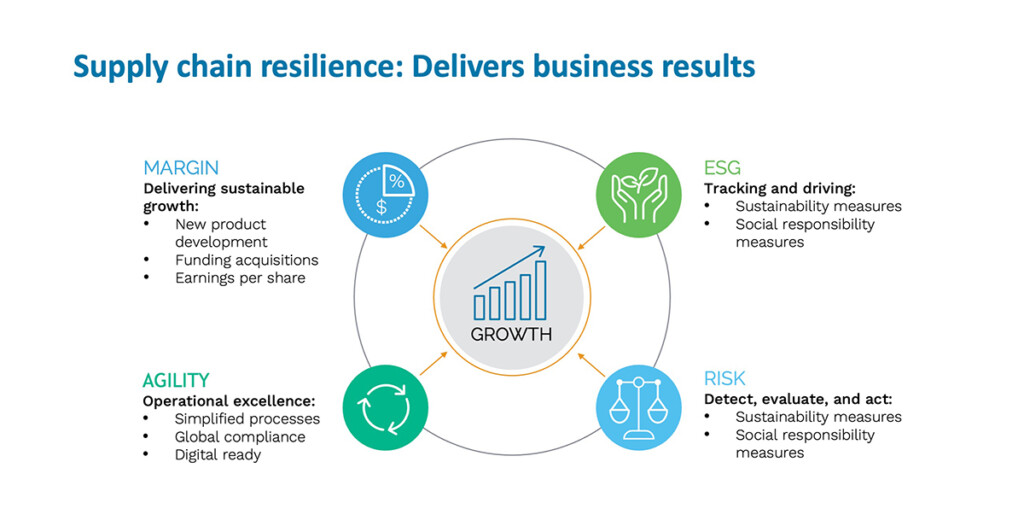In today’s interconnected world, supply chain resilience has become a buzzword for good reason. It’s all about a company’s ability to adapt to disruptions, maintain operations, and continue delivering products or services despite unforeseen challenges. Supply chain resilience via risk management isn’t just a strategic advantage; it’s a necessity in navigating the complexities of global trade, market fluctuations, and unexpected crises.
Why supply chain resilience matters
A resilient supply chain can mean the difference between a business that weathers the storm and one that finds itself capsized by it. Take, for instance, the tech giant Apple. By investing heavily in diverse suppliers and maintaining strong relationships, they can pivot quickly when a single supplier faces issues, ensuring that the latest iPhone still reaches eager consumers on time. It’s a prime example of resilience in action, demonstrating foresight and flexibility.
LEARN MORE ABOUT HOW SUPPLY CHAIN RISK MANAGEMENT WORKS: FREE DOWNLOAD
Building blocks of supply chain resilience
So, what goes into building a resilient supply chain? Companies like Toyota have set industry benchmarks with their “just-in-time” (JIT) supply chain strategy, minimizing inventory costs and reducing waste. However, after experiencing setbacks due to natural disasters, they learned to combine JIT with a strategic stockpile of critical components—showcasing that resilience is also about balance and preparedness.
Supply chain resilience flexibility
Exemplifying resilience, when the pharmaceutical industry faced unprecedented demand during global health crises, firms like Pfizer demonstrated formidable supply chain agility. They ramped up production and distribution networks to roll out essential vaccines globally, turning logistical challenges into a testament to what resilience—and a well-prepared supply chain—can achieve.
How achieve supply chain resilience
For businesses looking to forge resilient supply chains, the lessons are clear: diversify, prepare, and adapt. Whether facing a cargo ship stuck in a canal, a cyber-attack on a major supplier, or a sudden tariff change, resilience means having the strategy and systems in place to handle it all. Building resilience isn’t a one-time task—it’s an ongoing journey that requires commitment and the willingness to evolve.
By prioritizing supply chain resilience, companies don’t just survive; they thrive. It’s about creating a network that’s robust enough to handle today’s challenges and agile enough to adapt to tomorrow’s uncertainties. Are you ready to reassess and reinforce your supply chain?
Measuring supply chain resilience
The ability to quantify resilience in supply chain operations is invaluable for companies seeking continuous improvement. It starts with setting clear, measurable goals that highlight critical areas like supplier on-time performance, inventory turnover rates, and the flexibility of manufacturing processes. By regularly monitoring these key performance indicators, businesses can identify potential weaknesses before they escalate into significant issues.
Furthermore, investing in advanced data analytics allows for predictive modeling and stress testing. These tools give insights into how a supply chain might react under various adverse scenarios, enabling organizations to craft more informed, proactive strategies.
Supply chain resilience ROI

Figure 1: Supply chain resilience delivers business results in many operational areas including cost savings, and lower risk.
Objectively measuring resilience ultimately informs decision-making, allowing companies to make calculated choices that improve their operations while protecting against operational disruptions. This continuous loop of assessment and adaptation not only enhances the ability of a supply chain to recover from immediate setbacks, but it also strengthens the system against future challenges.
So, while it may seem like a daunting task to constantly monitor and improve supply chain resilience, the return on investment is undeniable. By prioritizing resilience, businesses can future-proof their operations and ensure sustainable success. No matter what challenges come their way, they will be ready to face them head-on with confidence and agility.
LEARN MORE ABOUT HOW SUPPLY CHAIN RISK MANAGEMENT WORKS: FREE DOWNLOAD